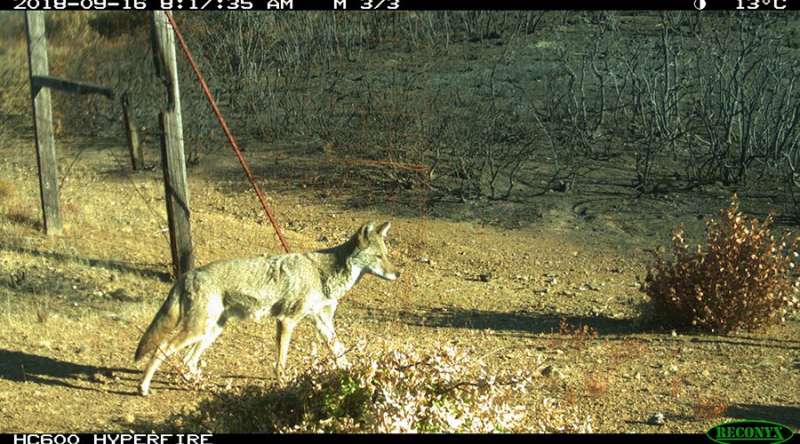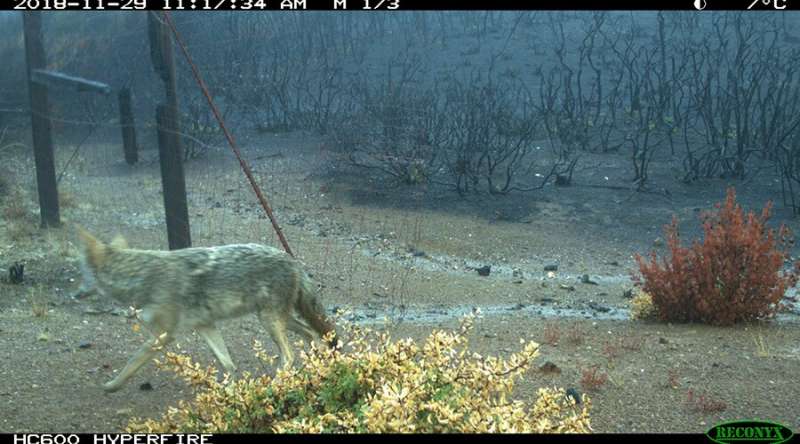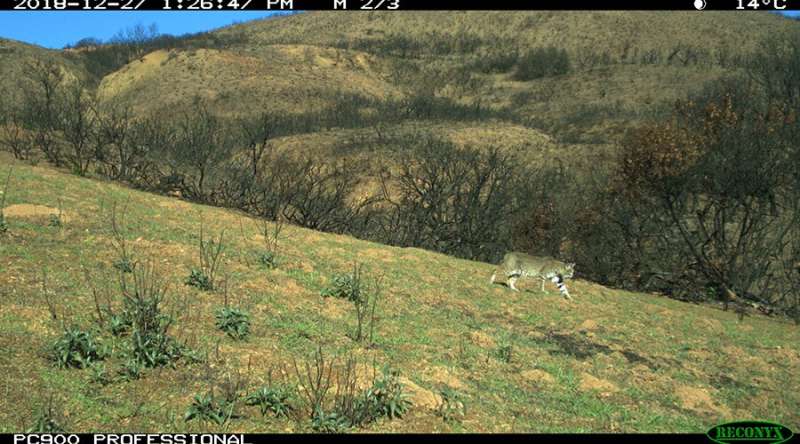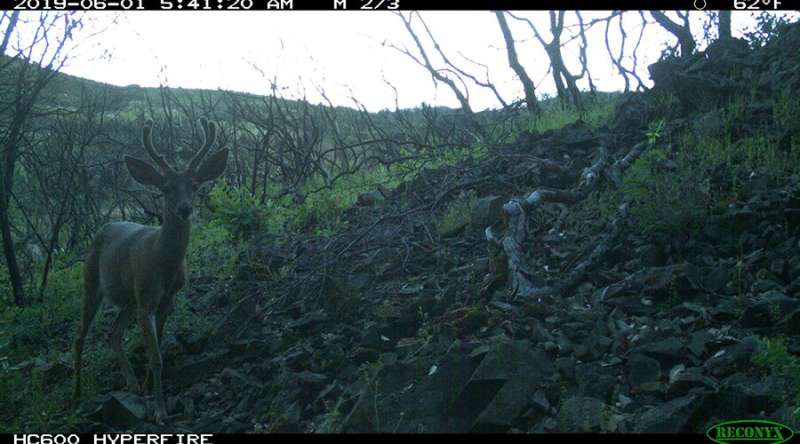This article has been reviewed according to Science X's editorial process and policies. Editors have highlighted the following attributes while ensuring the content's credibility:
fact-checked
peer-reviewed publication
trusted source
proofread
Hidden cameras spot wildlife returning home after 2018 megafire

During the summer of 2018, the Mendocino Complex Fire ripped through UC's Hopland Research and Extension Center (HREC), transforming the Northern California property's grassy, oak-dotted hillsides into a smoldering, ash-covered wasteland.
"It felt like something out of the Lord of the Rings—like Mordor. It was hard to imagine much surviving," said Justin Brashares, a professor of environmental science, policy and management at the University of California, Berkeley.
But mere months after the fire, animals like coyote, gray foxes and black-tailed jackrabbits were seen returning to the area, spotted by grid of motion-sensor camera traps that Brashares' lab has operated since 2016 at the HREC, a multidisciplinary research and education facility located on the banks of the Russian River about 13 miles south of Ukiah.
"We were surprised that many species seem to be resistant [to the impacts of the fire]," said Kendall Calhoun, a graduate student at UC Berkeley and a member of Brashares' lab.
Calhoun is the lead author of a new study that analyzed more that 500,000 camera grid images taken at the HREC in the years before and after the Mendocino Complex Fire to understand how the blaze impacted small- and medium-sized mammals on the property.
The study, which appeared in the journal Ecosphere, is one of the first studies to compare continuous wildlife observations made before and after a megafire. It is also one of a limited number of studies to focus on the impacts of megafires on California's oak woodlands. Oak woodland ecosystems comprise a large portion of the state, and yet are underrepresented in wildfire research compared to the conifer forests of the Sierra Nevada.

"For the great majority of Californians, these oak woodlands and grassland savannahs are what we think of as the characteristic biome or ecosystem type for our state," Brashares said. "It's the primary ecosystem type for livestock grazing, and it's also the primary habitat type that's used to grow grapes for wine. It's a critical ecosystem type, and it's worth managing well."
Of the eight animal species included in the study, six were found to be "resistant" to the impacts of the fire, using the area in the same ways and with approximately the same frequency as they did before the fire. These species included coyote, black-tailed jackrabbit, gray fox, racoon, striped skunk and bobcat. Western gray squirrel and black-tailed deer, however, appeared to be more vulnerable to the impacts of the fire.
Brashares and Calhoun believe many of the species were able to remain in the area thanks to small patches of tree cover spared by the fire. Photos from the camera traps reveal many animals taking refuge in these patches, using them to obtain food and resources while more heavily burned areas recovered. Some animals were even observed using these locations more often after the fire than before.
These findings highlight the importance of using techniques like grazing and prescribed burning to reduce the intensity of wildfires when they happen. These lower severity fires are more likely to leave the tree canopy intact and create the types of forest heterogeneity that can benefit fire-adapted ecosystems.
"Even this incredibly hot and devastating fire still managed to leave behind these little patches of unburnt areas, and we were surprised at how quickly many species were able to move into those habitat patches and then spread back out into the burned areas as they recovered," Brashares said. "This finding is very valuable for forest management because we can do things to the landscape that will increase the chance that when fire does come through, it will leave behind some of these fragments."

A menacing inferno
Calhoun was halfway around the world visiting New Zealand when he received a text message from study co-author Kaitlyn Gaynor informing him that the HREC was on fire.
For two years, Calhoun had been helping to maintain the 36 camera traps spread across the property that had been set up in collaboration with the California Department of Fish and Wildlife to test a new way to monitor wildlife populations across the state.
Calhoun had originally joined Brashares' lab hoping to study impacts of megafire on wildlife diversity, but the unpredictability of wildfire had made it difficult to find a study site. The Mendocino Complex Fire—while terrifying and destructive—provided him with a rare opportunity.
"From what I heard, it was really scary as the fire was coming up to the property because people live on site, so there was a big rush to evacuate. The fire ended up burning more than half of the area," Calhoun said. "I was a continent away when I found out, but I was interested in hitting the ground running and making sure we got all the data we needed when I got back."

Calhoun and the team first returned to the site about two months after the fire, when trees were still smoldering and the HREC resembled a "moonscape." The team's first task was to check on the cameras, 13 of which had been partially melted by the fire. In addition to replacing broken camera parts, they also checked to make sure the camera traps were set up at the same position and with the same orientation as they were before the fire, to ensure that their data remained as consistent as possible.
Every three months, the team visits all 36 cameras on the site, downloading the photos, ensuring that everything is working correctly and removing any grass or debris blocking the view. They then spend countless hours reviewing each shot to sort out which photos contain animals, then identify the animals and log the data.
"A lot of the data that we collect is just grass blowing in the wind," Calhoun said.
In addition to small- and medium-sized mammals, the cameras also capture photos of larger animals, like black bears and mountain lions. Because these apex predators have huge home ranges—often many times larger than the HREC's 5,300 acres—it is impossible to get accurate information about their distributions from the study area.
Calhoun said that, anecdotally, these animals were spotted much less frequently after the fire, suggesting that they were slower to return to the area after the blaze.
After completing his Ph.D. this summer, Calhoun plans to continue his work as a 2023 Smith Fellow, studying how broad changes in fire regimes are affecting wildlife species across California. As part of the work, he hopes to obtain broader scale data on apex predators to better understand what happens to these animals when large fires destroy their home ranges.
"For my next project, I'm really interested in looking at the broadscale effects of fire on those really wide-ranging species, like mountain lions and bears, and then also how wildfires might be impacting their relationship with people," Calhoun said. "The conflict between bears and humans, especially in Lake Tahoe, is really big in the in the news right now, and I think that either climate change or fire might be driving some of those interactions."
More information: Kendall L. Calhoun et al, Mammalian resistance to megafire in western U.S. woodland savannas, Ecosphere (2023). DOI: 10.1002/ecs2.4613
Journal information: Ecosphere
Provided by University of California - Berkeley




















